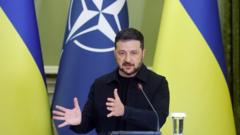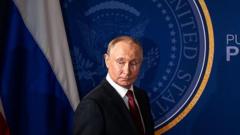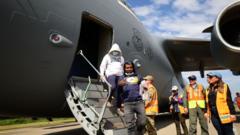The rapid advancement of hypersonic missile technology has ignited a modern arms race, with nations competing to develop weapons that travel at speeds exceeding five times the speed of sound. Leading the pack are China and Russia, with the US and its allies striving to catch up. This pursuit not only alters military strategies but raises significant concerns about global security dynamics.
**The Global Hypersonic Arms Race: A Fast-Evolving Battlefield**

**The Global Hypersonic Arms Race: A Fast-Evolving Battlefield**
As countries race to develop hypersonic missiles, the balance of military power is shifting amongst global powers like the US, China, and Russia.
The competition over hypersonic missile capabilities has heightened, particularly following China's display of its DF-17 missiles during a National Day parade in 2019. The speed and maneuverability of such weapons—flying at Mach 5 and beyond—have prompted security analysts to suggest they could transform warfare. Analysts like William Freer from the Council on Geostrategy indicate that the emergence of these military technologies reflects a broader geopolitical rivalry reminiscent of the Cold War.
China currently leads the hypersonic race, closely followed by Russia, while the US struggles to bolster its own capabilities after spending years focusing on counter-terrorism operations instead of potential conflicts with state actors. While other nations, including Israel and North Korea, are also developing hypersonic tech, the US is making strides, introducing its "Dark Eagle" missile in a bid to enhance deterrence.
Hypersonic missiles, categorized mainly as boost-glide or cruise missiles, present unique challenges for defense systems due to their stealth and unpredictable flight paths. Experts warn that traditional radar systems may fall short, advocating for enhanced space-based sensors for detection and threat mitigation.
Despite fears regarding these formidable weapons, some analysts argue the alarm surrounding them might be exaggerated. Although designed to penetrate defenses, both the attackers and defenders face substantial challenges in effective deployment and interception of these missiles.
Political dynamics continue to evolve, with Russia's recent military tests in Ukraine signaling tangible threats to surrounding NATO members. Concerns about the operational readiness of Russian hypersonics vary among experts, particularly regarding technology claims by Moscow.
Meanwhile, as the UK endeavors to close the gap on hypersonic technology, its recent collaborations with US defense agencies indicate a renewed commitment to competing on this front. The implications of the hypersonic arms race extend far beyond military might; they underscore the complexities of international relations in an increasingly multipolar world.
The question remains: How will these developments shape the future of global security and military strategy, and can nations devise effective countermeasures to mitigate the risks posed by hypersonic advancements?
China currently leads the hypersonic race, closely followed by Russia, while the US struggles to bolster its own capabilities after spending years focusing on counter-terrorism operations instead of potential conflicts with state actors. While other nations, including Israel and North Korea, are also developing hypersonic tech, the US is making strides, introducing its "Dark Eagle" missile in a bid to enhance deterrence.
Hypersonic missiles, categorized mainly as boost-glide or cruise missiles, present unique challenges for defense systems due to their stealth and unpredictable flight paths. Experts warn that traditional radar systems may fall short, advocating for enhanced space-based sensors for detection and threat mitigation.
Despite fears regarding these formidable weapons, some analysts argue the alarm surrounding them might be exaggerated. Although designed to penetrate defenses, both the attackers and defenders face substantial challenges in effective deployment and interception of these missiles.
Political dynamics continue to evolve, with Russia's recent military tests in Ukraine signaling tangible threats to surrounding NATO members. Concerns about the operational readiness of Russian hypersonics vary among experts, particularly regarding technology claims by Moscow.
Meanwhile, as the UK endeavors to close the gap on hypersonic technology, its recent collaborations with US defense agencies indicate a renewed commitment to competing on this front. The implications of the hypersonic arms race extend far beyond military might; they underscore the complexities of international relations in an increasingly multipolar world.
The question remains: How will these developments shape the future of global security and military strategy, and can nations devise effective countermeasures to mitigate the risks posed by hypersonic advancements?



















